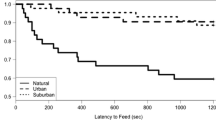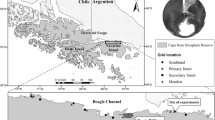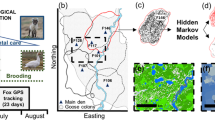Abstract
Free-ranging prairie rattlesnakes (Crotalus viridis viridis) exhibit lengthy vernal migrations upon emergence from winter hibernation. A series of laboratory experiments was designed to test hypotheses regarding the function and causation of vernal movements. Rattlesnakes obtained from Wyoming and Colorado populations were used. First, we hypothesized that the function of vernal movements is to locate small mammal prey. Second, we predicted that activeC. v. viridis use prey chemicals, as well as other cues, to decide whether or not rodents are present in an area. Third, we hypothesized that vernally active males would be more responsive to rodent prey and their odors than females, given observed differences in behavior in the field. Fourth, we predicted that rattlesnakes captured in Colorado would be more sensitive to prey odors than those obtained in Wyoming, because of disparate community structure and, hence, small mammal spatial distributions. As expected, snakes exhibited reduced activity, as well as certain other dependent measures reflecting predatory investigation, in arena zones containing either live rodents or their chemicals. However, responses to the latter were reduced in Wyoming rattlesnakes tested with chemicals from deer mice (Peromyscus maniculatus), relative to Colorado animals tested with chemicals obtained from house mice (Mus musculus). In contrast to patterns observed in nature, males and females exhibited almost no differences in overall responsiveness. Results are discussed in the context of simulation modeling and ongoing studies of prairie rattlesnake behavior.
Similar content being viewed by others
References
Arnold, S.J. 1981. The microevolution of feeding behavior, pp. 409–453,in A. Kamil and T. Sargent (eds.). Foraging Behavior. Garland STPM Press, New York.
Bellairs, A.d'A. 1984. Closing address, pp. 665–683,in M.W.J. Ferguson (ed.). The Structure, Development and Evolution of Reptiles. Zoological Society of London Symposium No. 52. Academic Press, New York.
Burghardt, G.M. 1970. Chemical perception in reptiles, pp. 241–308, in J.W. Johnston, Jr., D.G. Moulton, and A. Turk (eds.). Communication by Chemical Signals. Appleton-Century-Crofts, New York.
Diller, L.V. 1989. A field observation on the feeding behavior ofCrotalus viridis lutosus. J. Herpetol. In press.
Diller, L.V., andWallace, R.L. 1984. Reproductive biology of the northern Pacific rattlesnake (Crotalus viridis oreganus) in northern Idaho.Herpetologica 40:182–193.
Drummond, H., andBurghardt, G.M. 1983. Geographic variation in the foraging behavior of the garter snake,Thamnophis elegans.Behav. Ecol. Sociobiol. 12:43–48.
Duvall, D., andChiszar, D. 1989. Behavioral and chemical ecology of vernal migration and pre- and post-strike predatory activity in prairie rattlesnakes: Field and laboratory experiments,in D. Macdonald and D. Muller-Schwarze (eds.). Chemical Signals in Vertebrates 5. Oxford University Press, Oxford, England. In press.
Duvall, D., King, M.B., andGutzwiller, K.J. 1985. Behavioral ecology and ethology of the prairie rattlesnake.Natl. Geogr. Res. 1:80–111.
Gibbons, J.W., andSemlitsch, R.D. 1987. Activity patterns, pp. 396–421,in R.A. Seigel, J.T. Collins, and S.S. Novak (eds.). Snakes. Macmillan, New York.
Gillingham, J.C., andBaker, R.E. 1981. Evidence for scavenging behavior in the western diamondback rattlesnake (Crotalus atrox).Z. Tierpsychol. 55:217–227.
Gillingham, J.C., andClark, D.L. 1981. An analysis of prey searching behavior in the western diamondback rattlesnake,Crotalus atrox, Behav.Neural Biol. 32:235–240.
Golan, L., Radcliffe, C., Miller, T., O'Connell, B., andChiszar, D. 1982. Trailing behavior in prairie rattlesnakes (Crotalus viridis).J. Herpetol. 16:287–293.
Graves, B.M., andDuvall, D. 1983. Occurrence and function of prairie rattlesnake mouth gaping in a non-feeding context.J. Exp. Zool. 227:471–474.
Graves, B.M., Duvall, D., King, M.B., Lindstedt, S.L., andGern, W.A. 1986. Initial den location by neonatal prairie rattlesnakes: Functions, causes, and natural history in chemical ecology, pp. 285–304,in D. Duvall, D. Muller-Schwarze, and R.M. Silverstein (eds.). Chemical Signals in Vertebrates 4. Plenum, New York.
Gregory, P.T., MacArtney, J.M., andLarsen, K.W. 1987. Spatial patterns and movements, pp. 366–395,in R.A. Seigel, J.T. Collins, and S.S. Novak (eds.). Snakes. Macmillan, New York.
Halpern, M., andKubie, J.L. 1984. The role of the ophidian vomeronasal system in species-typical behavior.Trends Neurosci. 7:472–477.
Hennessy, D.F., andOwings, D.W. 1988. Rattlesnakes create a context for localizing their search for potential prey.Ethology 77:317–329.
King, M.B. 1987. Movements and natural history of prairie rattlesnakes,Crotalus viridis viridis, in Wyoming. Masters thesis. University of Wyoming, Laramie, Wyoming.
King, M.B., andDuvall, D. 1990. Prairie rattlesnake seasonal migrations: Episodes of movement, vernal foraging, and sex differences.Anim. Behav. In press.
Klauber, L.M. 1936. A statistical study of the rattlesnake.Occas. Papers San Diego Soc. Nat. Hist. 1:2–24.
Klauber, L.M. 1972. Rattlesnakes, 2 vol. University of California Press, Berkeley.
Kubie, J.L., andHalpern, M. 1978. Garter snake trailing behavior: Effects of varying prey extract concentration and mode of prey-extract presentation.J. Comp. Physiol. Psychol. 92:362–373.
Macartney, J.M., Gregory, P.T., andLarsen, K.W. 1988. A tabular survey of data on movements and home ranges of snakes.J. Herpetol. 22:61–73.
Martner, B. E. 1986. Wyoming Climate Atlas, University of Nebraska Press, Lincoln.
Reinert, H.K., Cundall, D., andBushar, L.M. 1984. Foraging behavior of the timber rattlesnake,Crotalus horridus.Copeia 1984:976–981.
Trivers, R.L. 1972. Parental investment and sexual selection, pp. 136–179,in B. Campbell (ed.). Sexual Selection and the Descent of Man, 1871–1971. Aldine, Chicago.
Author information
Authors and Affiliations
Rights and permissions
About this article
Cite this article
Duvall, D., Chiszar, D., Hayes, W.K. et al. Chemical and behavioral ecology of foraging in prairie rattlesnakes (Crotalus viridis viridis). J Chem Ecol 16, 87–101 (1990). https://doi.org/10.1007/BF01021270
Received:
Accepted:
Issue Date:
DOI: https://doi.org/10.1007/BF01021270




